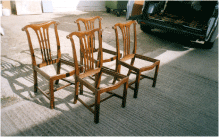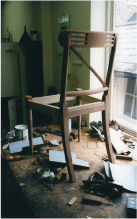About Restoration
Much of the skill of antique restoration lies in judging how best to bring a piece back to life whilst retaining as much of the original structure and pati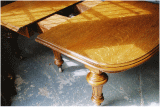 na as possible. To do this a restorer must have a thorough grounding in all the skills and techniques that can be employed, as well as an understanding of the history, construction, use and value of antique furniture in general.
na as possible. To do this a restorer must have a thorough grounding in all the skills and techniques that can be employed, as well as an understanding of the history, construction, use and value of antique furniture in general.
Woodwork
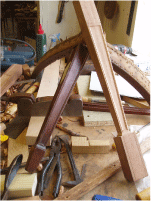 Where parts are damaged it is usually possible to splice-in new sections using appropriate timber in such a way that reduction of strength and breaks to the flow of grain are kept to a minimum. With the right finishing techniques
Where parts are damaged it is usually possible to splice-in new sections using appropriate timber in such a way that reduction of strength and breaks to the flow of grain are kept to a minimum. With the right finishing techniques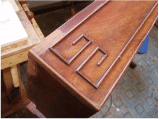 these repairs can be disguised so as to become unnoticeable.
these repairs can be disguised so as to become unnoticeable.
If components are too badly damaged or completely missing, the restorer has to turn to his skills in cabinet-making, wood-turning, carving and metal-working to replace them, and then employ his finishing skills so that the replacement is not apparent. Very few items of furniture which are one hundred years old or more, survive into the 21st Century without damage or alteration, which is only to be expected.
The problem of loose joints is remedied by various means. The common factor in all such repairs though, should be the use of traditional hide based glues which have many advantages over modern adhesives, chief amongst which is their solubility with warm water, which allows them to be reversed and minimises damage to finished surfaces.
Restoring finishes
Traditional French polish (shellac), wax and oil finishes can be greatly improved without having to completely strip and re-polish the surface. Depending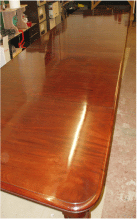
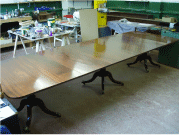 on condition, many dents, scratches, stains,etc. can be successfully removed or disguised. It is also sometimes possible to remove the top layers of finish, carry out repairs, colouring, bleaching, etc. and amalgamate a new finish on top. Simply polishing over an old finish may look fine for a while but the layers will seperate in time, with unsightly results.
on condition, many dents, scratches, stains,etc. can be successfully removed or disguised. It is also sometimes possible to remove the top layers of finish, carry out repairs, colouring, bleaching, etc. and amalgamate a new finish on top. Simply polishing over an old finish may look fine for a while but the layers will seperate in time, with unsightly results.
If a finish has to be completely stripped there is then much more scope for effective colour matching and/or bleaching. It should always be the aim of the restorer to get colour into the wood itself, rather than sitting in between layers of polish on the surface, as this tends to obscure the grain and give an undesirable patchy look. I am often asked to completely re-polish large dining tables for trade customers. When doing this I aim to produce a finish which is not too shiny, also, I usually avoid the use of grain-fillers which deaden the lustre of the finish.
Wood-turning and Carving
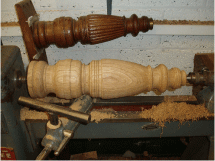 Wherever new sections are spliced into anything other than a completely straight and flat surface, it is necessary to use carving tools and techniques to create the right shapes and to blend the addition into its background. A selection of special moulding planes is also a valuable resource.
Wherever new sections are spliced into anything other than a completely straight and flat surface, it is necessary to use carving tools and techniques to create the right shapes and to blend the addition into its background. A selection of special moulding planes is also a valuable resource.
Woodturning skills are also essential for the repair or replacement of damaged or missing turned components. The dowelling used in my workshop is always turned by hand so that I'm sure of having the correct timber of exactly the right diameter. Tables and chairs with turned legs can be discreetly raised in height with the addition of a 'sympathetic' turning at the base.
Metalwork
The most common metalwork repairs in my workshop are to locks, keys and castors which are repaired using silver-soldering or oxy-acetylene 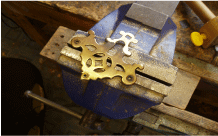 soldering techniques. I can also have steel work braized or welded. If you have lost a key or need one copied, I can cut a new one from an appropriate blank. It is sometimes possible to cut a new key for a drawer or door which is still locked, if not, it is still advisable to ask a restorer if they can get it open without drastic measures being taken. Replacement handles, knobs, escutcheons and other fittings can also be sourced and fitted for you.
soldering techniques. I can also have steel work braized or welded. If you have lost a key or need one copied, I can cut a new one from an appropriate blank. It is sometimes possible to cut a new key for a drawer or door which is still locked, if not, it is still advisable to ask a restorer if they can get it open without drastic measures being taken. Replacement handles, knobs, escutcheons and other fittings can also be sourced and fitted for you.
Leather and Baize Liners
I can supply and fit new leathers (skivers or hides) to desk tops etc. When doing so, care is always taken to ensure that the groundwork is stable and sound. I can also supply and fit baize inserts for card tables, etc.
Copies or Reproductions
If you have an item of furniture of which you would like a copy made, an antiques restorer with excellent cabinet making skills is the person to turn to. Knowledge of period materials, hand-tool techniques and finishing skills are very important. The most common request is for copies of chairs to extend a set, from say 6, to 8 or more.
